DIY Flag Burning Steps

Each year, between Flag Day (June) and Independence Day (July), many hold ceremonies to properly dispose of the American Flag. These ceremonies often result in the burning of an American Flag that has become worn through use and is no longer serviceable.
Burning an American flag is addressed in the United States Flag Code and there are specific procedures required to dispose of a worn, damaged, or no-longer-serviceable American flag.
Flag burning is serious business, and there is an important safety component associated with any ceremony designed to properly burn a flag. The largest source of house fires in America involves unattended heat sources including open flame. Do not leave a source of flame or ignition unattended, do not burn a flag without a fire extinguisher, and do not let children handle flame or ignition sources.
Properly Disposing of Your Flag: DIY Flag Disposal
To conduct a private disposal ceremony, the Veterans of Foreign Wars advises the following steps:
- Fold the flag
- Ensure fire is large enough to consume the flag
- Place flag in/onto fire
- Salute
- Recite the Pledge of Allegiance, hold a moment of silence
According to the Veterans of Foreign Wars, the American flag must be folded in the proper manner before disposal. This ensures that the colors are properly formed to be consumed by fire all at once.
As for the place where you intend to burn the flag, the area must be large enough to accommodate the wholeness of the folded flag, so as not to leave any part of it unconsumed.
Carefully place the folded flag into or onto the fire you’ve prepared. In some cases, you may be placing the flag into a large flame, so please be careful not to burn yourself.
Once you’ve placed the folded colors in the ceremonial flames, render a salute, either military or civilian, and recite the Pledge of Allegiance. Alternatively, holding a moment of silence as the flag is consumed is also appropriate and respectful.
Once the fire wholly consumes the flag, safely extinguish the flames. When possible, collect and bury the ashes. Of course, the VFW insists that you follow all local and state ordinances when it comes to open flames.
An Alternative to Flag Burning
While a ceremonial burning of the flag is considered the most appropriate method of disposal, another option that is less often used is burying the flag. Since the ashes of burned flags are often buried, this method foregoes the flame and moves directly into burial.
According to guidance from the National Flag Foundation, an American flag must be:
- Folded properly
- Placed in a respectable box or container
- Buried, with a moment of silence
This is appropriate when the worn flag is composed of synthetic material, like nylon, that can emit hazardous fumes when burned. Or, if someone does not live near an organization that collects worn flags, this method is appropriate.
Where to Take Worn US Flags
Throughout the year, various organizations collect worn flags via drop-boxes at their locations. They include:
- The American Legion
- Veterans of Foreign Wars
- The Boys Scouts
- The Girl Scouts
Additionally, many police and fire stations will accept worn American flags. They may hold a ceremony themselves or make sure that one of the organizations listed above receives them.
The landfill near my home also has a box in the recycle center that collects American flags for disposal. Check your local facility.
The American Legion Ceremony
The American Legion has a special Ceremony for Disposal of Unserviceable Flags, which was adopted in September of 1937. The reason the Legion adopted such a ceremony was to encourage respect for our Nation’s colors and to ensure that worn flags were disposed of in a dignified manner.
In this ceremony, the entire Post assembles outdoors, usually at night, and forms two parallel rows of people facing each other about 20 feet apart.
As the flags are brought up, the Sergeant-at-Arms facilitates an inspection of the flags by senior Legion members. Once they are all inspected, the Legion Commander forms the Color Guard and the Chaplain offers prayer.
All members who are not part of the Color Guard salute as the flags are dipped in kerosene and placed in the fire. At the same time, a bugler plays “To the Colors
RELATED:
- 4th of July Sales and Discounts for Military, Veterans
- How to Celebrate Father’s Day, by Service Branch
- Four Chaplains Day, February 4th
- The History of the 4th of July
- Veteran Asbestos Exposure and VA Policy
- VA Home Loan Policy Updates
About the author
Julie Provost is a freelance writer, and blogger. She lives in Tennessee with her National Guard husband and three boys.


